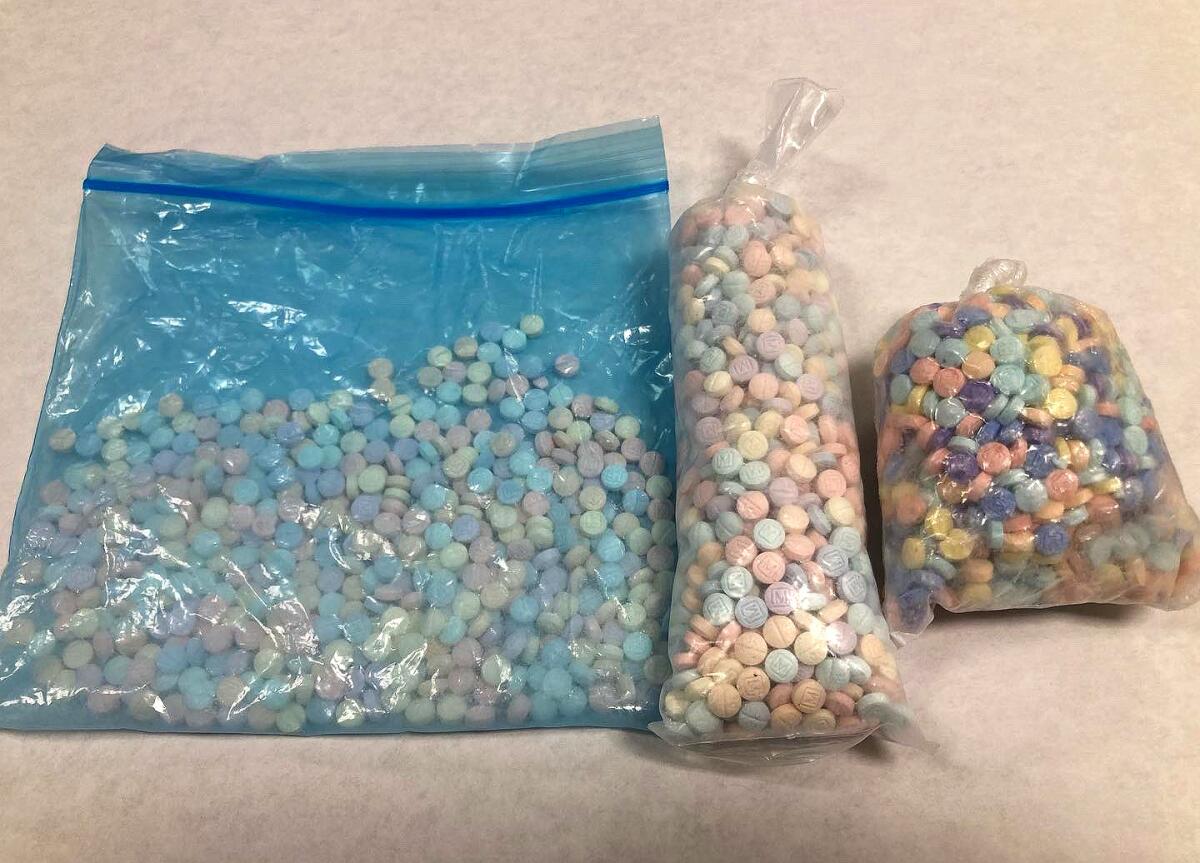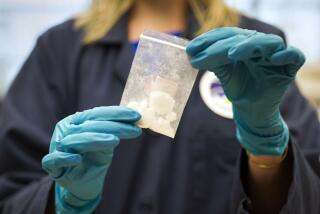Los Angeles crime lab finds 4% of seized fentanyl samples contain flesh-eating sedative

- Share via
Five months after public health officials warned Angelenos that a dangerous, flesh-eating sedative may have infiltrated the illicit drug supply, the Los Angeles County Sheriff’s Department confirmed that it has arrived on the city’s streets.
Results from a three-month pilot program showed that just over 4% of seized fentanyl samples tested by the department’s crime lab came back positive for xylazine, an animal tranquilizer that experts say is frequently mixed with illicit opioids to prolong the high.
Also known as “tranq,” the drug first began appearing several years ago in illicit pills and powders on the East Coast. It’s been linked to deaths across the country and can cause human tissue to rot, leaving users with grisly wounds that sometimes lead to amputations. Because xylazine is not an opioid, it can render naloxone, a life-saving medication commonly used to reverse heroin and fentanyl overdoses, ineffective.
“These findings highlight that the illicit drug supply in Los Angeles County remains dangerous and contains substances such as xylazine that can increase overdose deaths,” a county news release announcing the findings said Wednesday. “People who are obtaining these drugs may not be aware that xylazine is present.”
Chelsea Shover, a UCLA researcher who studies drug use, welcomed the findings and said she hoped the initiative would continue.
It was at least four years ago that L.A. County Sheriff’s Department officials say they began finding signs of a dangerous sedative in street drugs.
“It is encouraging to see the effort to track xylazine in the illicit drug supply, and it’s also encouraging that so far the presence has been pretty low,” she told The Times on Wednesday. “But continuing to monitor this is going to be important because, as we have seen in other cities, xylazine can start at a low prevalence and becomes a major part of the drug supply.”
The first clear sign of the drug’s presence in the Los Angeles area came in February, when a county health official confirmed to The Times that one man — a 25-year-old in El Monte — had trace levels of xylazine in his body when he died in December 2021.
The following month, the county issued a news release alerting the public to the dangers of xylazine, but said it wasn’t certain whether the drug was present on the streets of Los Angeles. Weeks later, The Times learned that the Sheriff’s Department crime lab had been detecting signs of xylazine in drug samples for at least four years — but hadn’t told the health department or the public, or tracked how frequently it had been occurring.
Sheriff’s Department officials said that, despite its potential harms, xylazine is not illegal, so formally tracking it or doing confirmatory testing was beyond the scope of their work. “There are a bunch of different additives — like vitamin C, which comes up a lot — that we don’t write down,” Capt. Ernest Bille, who oversees the department’s Scientific Services Bureau, said at the time. “The mission, given the volume of the caseload that we have, is to figure out: Is this a controlled substance or not?”
After concerns raised by UCLA researchers and reporting published by The Times,the Sheriff’s Department on April 11 launched a three-month pilot program to track xylazine in the illicit drug supply.
In total, the Sheriff’s Department tested 4,608 drug samples, according to a news release Wednesday. Roughly 3,000 of those samples came up positive for methamphetamine, which Bille said is typically the “most predominant” substance the lab’s analysts find in drug seizures. Of the 320 samples of fentanyl and its chemical cousins the lab tested, 13 — or just over 4% — contained xylazine.
Two of 13 were mixtures of methamphetamine, fentanyl and xylazine, and one was a tar-like mixture of heroin, fentanyl and xylazine. The rest were all fentanyl mixed with xylazine, Bille said.
The rapid spread across the country of xylazine, also known as “tranq,” has local health officials worried it will exacerbate an already alarming overdose crisis.
Many of the xylazine-laced samples were powders, though four were a commonly counterfeited type of blue pill known as an M30. At least one sample was a “compressed powder” from what Bille described as a “kilo-size brick” seizure.
All of the drugs tested were seized in conjunction with criminal cases, officials said. Despite the variety of locations and sample sizes, officials cautioned that it’s not clear whether the results are representative of how prevalent the drug is in the community. Nationally, 23% of fentanyl powder seized by the U.S. Drug Enforcement Administration last year contained xylazine, according to federal data.
As concerns about xylazine have garnered more attention in recent months, some federal legislators have begun pushing to criminalize it. The Combating Illicit Xylazine Act, a bipartisan bill introduced in March, would classify the sedative as a Schedule III controlled substance, in the same category as ketamine, anabolic steroids, and some codeine products. Xylazine is not approved for human use but is commonly used to sedate cattle, horses and zoo animals.
Shover, the UCLA researcher, said that without more information about the source of the xylazine appearing in street drug supplies, it’s not clear whether a legal crackdown would do much to reduce its availability.
“If it’s being diverted from veterinary supplies, then scheduling it could have an effect,” she said. “But if it’s being synthesized on its own, then I wouldn’t expect scheduling it to be much of a deterrent.”
Instead, she said, a more effective approach would be to focus on increasing the availability of test strips that allow users to check their own drugs for xylazine.
“If you have a drug market like Los Angeles where xylazine is pretty rare and you scale up testing strips, that could prevent widespread proliferation if people are able to avoid using xylazine and prevent it from taking hold the way it has elsewhere,” she said. “And any time you schedule a substance, I worry about the possibility of something stronger coming along to replace it.”
More to Read
Sign up for Essential California
The most important California stories and recommendations in your inbox every morning.
You may occasionally receive promotional content from the Los Angeles Times.













